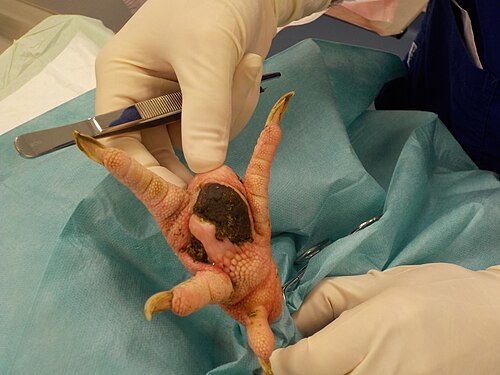Online Chicken Bumblefoot Treatment from Home
Online chicken bumblefoot treatment consultation - only $65. Get expert virtual vet care for your flock's foot infections without leaving home.
TALK TO A VET

Bumblefoot (plantar pododermatitis) is a serious bacterial infection: What is Bumblefoot? • Bacterial infection of the foot pad • Usually caused by Staphylococcus bacteria • Can affect one or both feet • Progressive condition if untreated Common Causes: • Sharp objects in coop or run • Hard landing surfaces • Poor sanitation • Obesity or excessive weight • Vitamin A deficiency • Poor quality perches
Early detection is crucial for successful treatment: Early Signs: • Limping or favoring one foot • Small black scab on footpad • Mild redness or swelling • Slight warmth in affected area Advanced Symptoms: • Significant swelling of foot • Large, dark scabs • Obvious pain when walking • Reduced activity • Loss of appetite • Infected tissue or abscess • Difficulty perching
Our veterinary team provides comprehensive bumblefoot care: 1. Professional Assessment • Evaluation of infection stage • Determination of severity • Review of contributing factors • Development of treatment plan 2. Treatment Guidance We provide detailed instructions for: • Proper foot soaking techniques • Wound cleaning protocols • Bandaging methods • Antibiotic administration • Post-treatment care 3. Ongoing Support • Regular progress monitoring • Treatment adjustments as needed • Prevention strategies • Recovery timeline expectations 4. Environmental Modifications • Coop improvement recommendations • Perch modifications • Sanitation protocols • Risk factor reduction
Essential care practices for managing bumblefoot: 1. Daily Care Requirements • Clean, dry environment • Proper bandage maintenance • Regular medication administration • Activity level monitoring 2. Treatment Procedures • Warm water soaks • Gentle cleaning of affected area • Application of prescribed medications • Proper bandaging techniques 3. Environmental Adjustments • Softer perching areas • Clean, dry bedding • Removal of sharp objects • Improved sanitation 4. Recovery Support • Proper nutrition • Stress reduction • Limited jumping/activity • Regular foot checks
Contact Telavets immediately if you notice: • Severe swelling or discoloration • Spreading infection • Foul odor from the wound • Bird stops eating or drinking • Extreme lethargy • Signs of systemic infection • Inability to stand or walk Early intervention is crucial for preventing complications. Our veterinarians can provide guidance on whether immediate surgical intervention is necessary.
As a practicing poultry veterinarian with 22 years of experience treating foot infections, I've developed surgical and medical protocols that achieve over 90% cure rates when implemented correctly. Early intervention is critical for successful outcomes. Evidence-Based Treatment Approaches: • Surgical debridement under local anesthesia • Complete removal of infected core material • Systemic antibiotics: Amoxicillin 20mg/kg twice daily for 10-14 days • Topical treatment: Silver sulfadiazine cream applied twice daily • Proper wound care and bandaging Success depends on complete removal of infected material and preventing reinfection. Cases caught early show 95% cure rates.
Throughout my veterinary career specializing in poultry health, environmental management has proven to be the most effective prevention strategy. Well-designed coops and runs can eliminate 95% of bumblefoot cases. Critical Prevention Strategies: • Rounded perches 2-4 inches in diameter prevent pressure points • Remove all sharp objects from coop and run areas • Maintain dry conditions and proper drainage • Ensure adequate Vitamin A: 8,000-10,000 IU/kg in feed • Weekly foot examinations during routine handling • Clean coops weekly with thorough disinfection In my practice, flocks following comprehensive prevention protocols show 90% fewer foot problems.